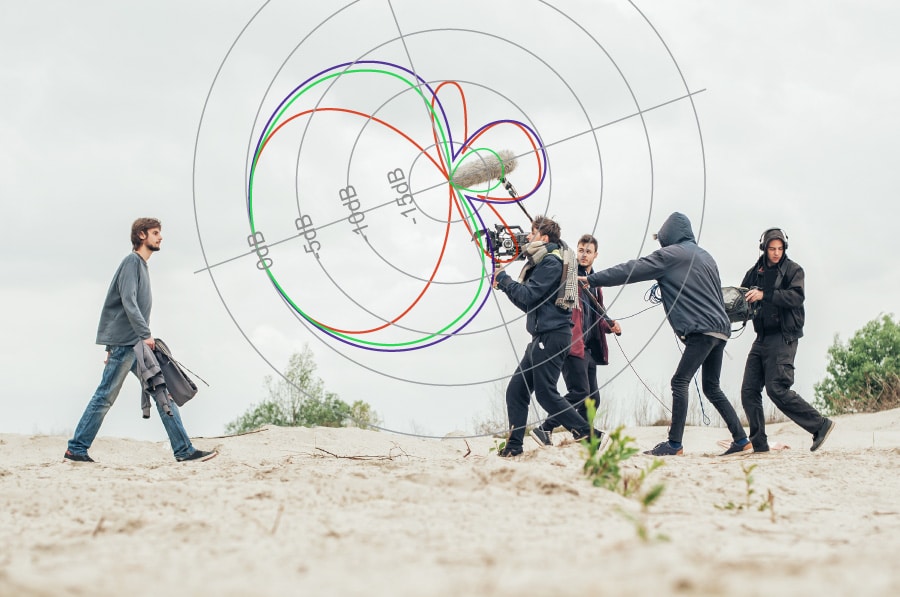The term polar pattern describes how a microphone picks up sound. More specifically, it describes how sensitive the microphone is to sound waves coming in from different directions. A microphone’s polar pattern is an important consideration when it comes to figuring out if a microphone is the right or wrong tool for a particular situation. So it’s important for filmmakers to know what the different polar patterns are, how they work, and in what situations to employ them.
Omnidirectional
The simplest microphone polar pattern to understand is omnidirectional, or often just called omni. As the name would suggest, an omni microphone picks up sound equally from all directions. This means that the direction the microphone is pointing is not important, and proximity is the main factor in how strongly it picks up a sound.

In film making applications, omnidirectional microphones are best suited for lavaliers. The omni characteristic gives you the freedom to clip the microphone on your speaking subject in any orientation, while giving you the added benefit of consistent sound levels even if your subject moves their head from side to side. Azden’s wireless PRO-XD lavalier system, and EX-503i smartphone lavalier, are both examples of omnidirectional microphones.
Directional
There are actually a few different types of directional microphones. Cardioid (kar-dee-oid) is the most common directional polar pattern, with the highest sensitivity to sound coming in from directly in front of the microphone capsule (0º), practically no sensitivity to sound coming directly from behind (180º), and a reduced sensitivity to sound coming in from the sides (90º/270º).
A cardioid mic is a lot better at excluding background noise and room reflection than an omni mic. Its most common use is actually in music production and live sound reinforcement. But filmmakers will encounter cardioid mics too, especially in stereo microphones. For example, Azden’s SMX-30 Stereo/Mono Switchable Video Microphone uses two cardioid microphones angled apart at 120º to capture sound in stereo, similar to the way our ears hear.
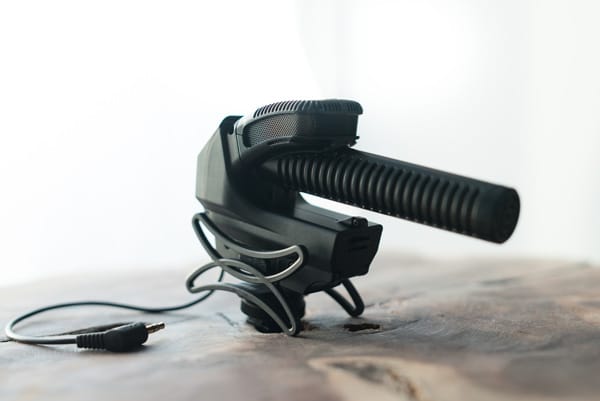
Supercardioid, as the name suggests, is like cardioid but more directional. It exhibits even less sensitivity to sound coming in from the sides compared to a regular cardioid, but with a bit more sensitivity to sound at the rear. Despite that, supercardioids perform better when it comes to eliminating background noise and focusing in on a sound source.
Shotgun Microphones
A supercardioid microphone element can be made even more directional when placed inside of a shotgun microphone. The thin slots that run down the sides of a shotgun microphone barrel actually create phase cancellation in sound waves arriving from the sides, while sound arriving directly through the front of the barrel is unaffected. This makes the directional performance of a supercardioid mic even better, especially at higher frequencies.
The perfect application for shotgun microphones, as far as filmmakers are concerned, is when you want to record dialogue in a scene but don’t want to have the microphone visible in the shot. This requires that you place the microphone a certain distance away, out of frame, often above your talent on a boom pole. Azden’s SGM-250 and SGM-250P shotgun microphones are two examples of supercardioid shotgun mics that are great for dialogue.
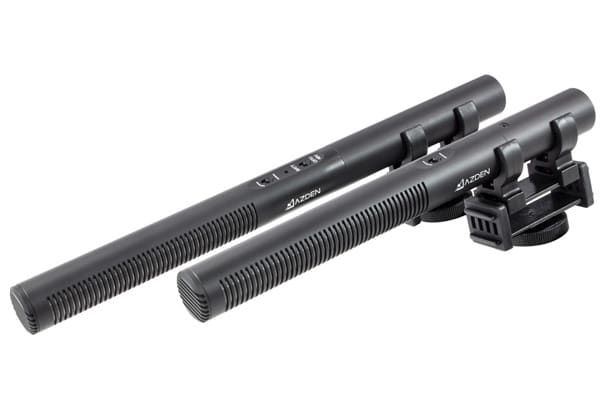
A common misconception about shotgun microphones is that they “reach out” and “grab” the sound from far away distances. That’s not really how they work. In reality, the shotgun microphone just leaves out more of the stuff you don’t want. Think of it like shining a flashlight on a wall. Within a foot or two of the wall the flashlight’s beam appears as a well defined circle on the wall. As you move further away, that circle gets bigger and less defined until there is no longer a discernible shape. That’s kind of how a shotgun mic will pick up sound; if you want to be laser focused on your sound source, you still want to get fairly close. The further away you move from your sound source the less defined it will become.
Other Polar Patterns
For the sake of brevity we haven’t gone into detail on every type of microphone polar pattern. We’ve covered the most common types that filmmakers will encounter, but if you want to continue exploring the topic, other polar patterns include subcardioid, hypercardioid and figure-8.
Reading Polar Pattern Charts
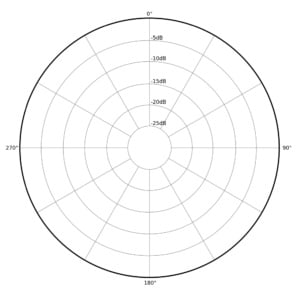
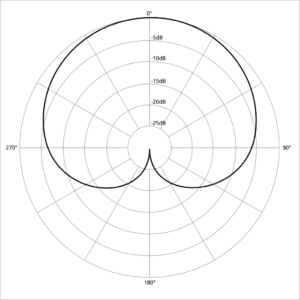
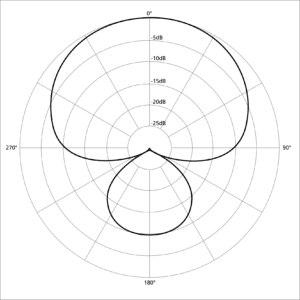
So how does one figure out a microphone’s polar pattern? The way it’s typically done is a frequency is played over a loudspeaker (most commonly a 1 kHz tone) and then the microphone itself is rotated 360 degrees while its output is measured. The measurements are then plotted on a circular chart. The data plot creates a distinctive shape which is identifiable as a particular type of “polar pattern.”
The simplest polar pattern chart to read is that of an omnidirectional microphone (Fig. 1). The resulting shape is a perfect circle, since this type of microphone picks up sound equally from all directions.
As for the cardioid pattern chart (Fig. 2), you can see at 90º and 270º off-axis the incoming sound was measured to be about -7 dB compared to 0º (on-axis). This means this microphone is rejecting sound from the sides. Sound rejection is the most significant at 180º off-axis; greater than -25 dB. This is exactly what you’d expect from a cardioid microphone.
Now, compare the cardioid with this supercardioid chart (Fig. 3). The biggest difference is the increased response from 180º off axis. Still at this angle the sensitivity is -10 dB compared to on-axis. However, rejection is maximized at 120º and 240º and is still less sensitive than the cardioid at 90º and 270º. So our supercardioid microphone is showing much better rejection of side noise than the cardioid.
It’s worth noting that the charts above represent sensitivity of just one sound wave frequency (1 kHz). However, it is common to see charts that plot sensitivity of multiple frequencies which can differ greatly. Lastly, don’t overlook that while polar pattern charts are obviously two-dimensional, in real life microphones operate in 3-D space.

